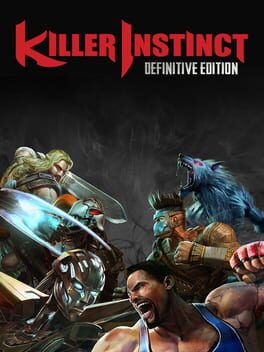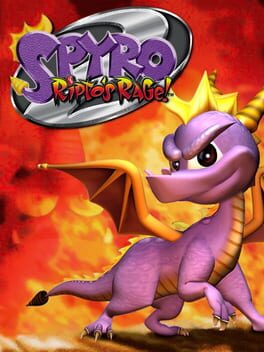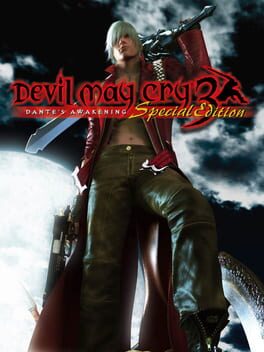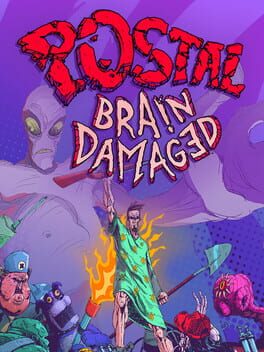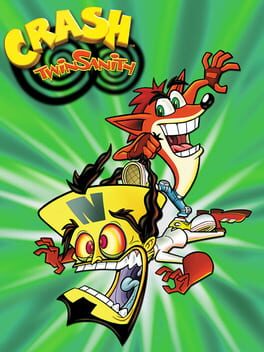NotSoSeriousNick
Bio
24 year old, He/Him. Half-Italian, Half-Romanian, full dumbass. Human embodiment of anxiety, occasionally videogame enjoyer.
24 year old, He/Him. Half-Italian, Half-Romanian, full dumbass. Human embodiment of anxiety, occasionally videogame enjoyer.
Badges

1 Years of Service
Being part of the Backloggd community for 1 year

Gamer
Played 250+ games

GOTY '22
Participated in the 2022 Game of the Year Event

Noticed
Gained 3+ followers

N00b
Played 100+ games
Favorite Games
308
Total Games Played
001
Played in 2024
151
Games Backloggd
Recently Played See More
Recently Reviewed See More
"This can't be good for me..."
POSTAL: Brain Damaged is a rarity in this specific franchise: a game that isn't held together by glue, chewing gum and violent dreams.
You play as The Dude, who is quite literally lost into his own mind trying to get his TV back from...himself, all the while going through the, pardon my French, fucked up parts of his psyche.
It's very clear from the moment you get your hands on the game's double-barreled, chain-hooked shotgun that this game owns a lot to DOOM Eternal, and that inspiration becomes even more evident as the game progresses, from its encounters to its level design.
The guns, which very from the relatively mundane pistols, double-barrels and miniguns to the much more absurd didlo-shooting bows and holy grenade launchers, all feel good to shoot, most of them having very interesting secondary fires to booth.
Visually the game looks pretty darn good, with the art-direction going for a pseudo-pixellated 3D style, which imo will probably age better than the more visually standard main titles in this franchise. Sound-wise you can kinda spot some stock sound effects here and there, the voice acting is relatively minimal and it's usually just one liners both the protagonist and it enemies will repeat semi-frequently (you can toggle said frequency in the menus). The OST, while not groundbreaking at all, does have some pretty memorable tracks that fit with the levels they are in particurarly well.
The game is structured in three Episodes, so to speak, each made up of five levels and each ending with a boss fight. While the structure itself isn't a problem, the levels themsels sometimes are, do to their very open and labyrinthine nature, which leads to you sometimes not being sure where to go in order to progress. Visually they all look very distinct and fundamentally there isn't an arena or encounter that is particurarly terrible on normal, but do not be surprised if after a fight you need to look up a guide to know where a button is and such.
Being a POSTAL game, it's irreverent and aims to insult just about everyone (admittedly Brain Damaged isn't as insensitive as the mainline games tend to be), and just like a POSTAL game it rarely actually is funny, but much like, say, Borderlands, if you are like me you tend to turn your brain off and just enjoy the carnage, which is, I am sure, what the devs intended anyhow.
You can also piss on people and there's even power-ups for that so I guess I have to give this game a 10/10 in restrospect.
POSTAL: Brain Damaged is a rarity in this specific franchise: a game that isn't held together by glue, chewing gum and violent dreams.
You play as The Dude, who is quite literally lost into his own mind trying to get his TV back from...himself, all the while going through the, pardon my French, fucked up parts of his psyche.
It's very clear from the moment you get your hands on the game's double-barreled, chain-hooked shotgun that this game owns a lot to DOOM Eternal, and that inspiration becomes even more evident as the game progresses, from its encounters to its level design.
The guns, which very from the relatively mundane pistols, double-barrels and miniguns to the much more absurd didlo-shooting bows and holy grenade launchers, all feel good to shoot, most of them having very interesting secondary fires to booth.
Visually the game looks pretty darn good, with the art-direction going for a pseudo-pixellated 3D style, which imo will probably age better than the more visually standard main titles in this franchise. Sound-wise you can kinda spot some stock sound effects here and there, the voice acting is relatively minimal and it's usually just one liners both the protagonist and it enemies will repeat semi-frequently (you can toggle said frequency in the menus). The OST, while not groundbreaking at all, does have some pretty memorable tracks that fit with the levels they are in particurarly well.
The game is structured in three Episodes, so to speak, each made up of five levels and each ending with a boss fight. While the structure itself isn't a problem, the levels themsels sometimes are, do to their very open and labyrinthine nature, which leads to you sometimes not being sure where to go in order to progress. Visually they all look very distinct and fundamentally there isn't an arena or encounter that is particurarly terrible on normal, but do not be surprised if after a fight you need to look up a guide to know where a button is and such.
Being a POSTAL game, it's irreverent and aims to insult just about everyone (admittedly Brain Damaged isn't as insensitive as the mainline games tend to be), and just like a POSTAL game it rarely actually is funny, but much like, say, Borderlands, if you are like me you tend to turn your brain off and just enjoy the carnage, which is, I am sure, what the devs intended anyhow.
You can also piss on people and there's even power-ups for that so I guess I have to give this game a 10/10 in restrospect.
Crash Twinsanity is a broken, unfinished mess. A hodgepodge of ideas thrown together, not all being used to their full potential, with an "open world" that wears its presence thin when whole segments can be accidentally re-triggered and with no way to go back without reloading a previous save.
It is my favorite Crash Bandicoot game ever made.
Crash Twinsanity is the result of the effort of Traveller's Tales, a studio born out of the shutdown of their previous iteration called Traveller's Tales (yes, I know). Famously released unfinished and broken, Crash Twinsanity has achieved a bit of a cult status among Crash fans, with people such as myself being able to ignore the (myriad) of problems the game is riddled with thanks to TT's willingness to experiment with the formula, and dedication to keep the tone as crazy and funny as it could possibly be.
The game follows after the ending of the previous game, Wrath of Cortex, three years after, to be precise. Everyone's favorite evil scientist starts our adventure by paralyzing Coco Bandicoot, disguising himself as her, and luring our intrepid protagonist to a trap deep in the jungle of N.Sanity island.
We are then free to follow Cocortex or explore N.Sanity Beach, one of many interconnected segments in Twinsanity. The narrow, corridor-like levels of classic Crash Bandicoot have been replaced with wider, "open" levels, each hiding puzzles and platforming challenges for those willing to snatch every gem in the game (now no longer tied with the box counter of old).
Crash's gameplay is about the same as every previous entry, so it is rock solid, but it isn't the only style offering in store for us: as we progress, Twinsanity will change its gameplay from platformer, to a Marble Madness' inspired section where we control a Cortex and Crash as they tussle around, to Crash dragging around Cortex and using his giant head as a malled and a spin-extension, to snowboarding segments (the snowboard being an unwilling Cortex, who in this game gets royally Squidwarded, pardon the term), to, eventually, playing as Cortex himself, in shooting segments with very little platforming (a disappointment, considering this was one of the game's selling points).
Finally, there's Cortex'sdaughter niece Nina, who is even more underutilized. Armed with giant fists that act as grappling hooks and allow her to wall jump, she is literally played only twice in the entire game. Hers is an encapsulation of the game's biggest flaw: missed potential. Traveler's Tales threw everything at the wall to see what stuck, being limited in time to what they could allow remaining on the wall, whilst still having stuff to throw at it to boot.
Somewhat softening the blow is the game's presentation, as Twinsanity is vibrant and colorful, models are expressive, a much more impressive look when compared to Wrath of Cortex. Accompanying the visuals are the performances the VA put forth, of note is Cortex's, who really sells the sheer pain his character is (hilariously, admittedly) put through. Finally, all is tied up by the game's now legendary soundtrack, all performed a cappella by the group Spiralmouth who really give Twinsanity much of its zany personality.
Of course with the good one must point out the bad, and sadly Twinsanity has plenty: the game is held up by code tied together, it seems, by wet and soft spaghetti, as glitches abound and are frequent enough to become a problem should you not have the patience for it. A couple of times it is completely possible to accidentally access and re-do entire segments previously finished with no way to backtrack to safety until you have completed them again, should you not have finished beforehand.
Whether you enjoy Twinsanity or not is highly dependant on your patience for these things, because there is no hiding them, as you cannot hide there was much more to the game that did not make it in. I, personally, love this game, flaws and all, for its personality and presentation and for being incredibly fun beyond those issues.
Maybe I'm just insane, tho. Fitting, isn't it?
It is my favorite Crash Bandicoot game ever made.
Crash Twinsanity is the result of the effort of Traveller's Tales, a studio born out of the shutdown of their previous iteration called Traveller's Tales (yes, I know). Famously released unfinished and broken, Crash Twinsanity has achieved a bit of a cult status among Crash fans, with people such as myself being able to ignore the (myriad) of problems the game is riddled with thanks to TT's willingness to experiment with the formula, and dedication to keep the tone as crazy and funny as it could possibly be.
The game follows after the ending of the previous game, Wrath of Cortex, three years after, to be precise. Everyone's favorite evil scientist starts our adventure by paralyzing Coco Bandicoot, disguising himself as her, and luring our intrepid protagonist to a trap deep in the jungle of N.Sanity island.
We are then free to follow Cocortex or explore N.Sanity Beach, one of many interconnected segments in Twinsanity. The narrow, corridor-like levels of classic Crash Bandicoot have been replaced with wider, "open" levels, each hiding puzzles and platforming challenges for those willing to snatch every gem in the game (now no longer tied with the box counter of old).
Crash's gameplay is about the same as every previous entry, so it is rock solid, but it isn't the only style offering in store for us: as we progress, Twinsanity will change its gameplay from platformer, to a Marble Madness' inspired section where we control a Cortex and Crash as they tussle around, to Crash dragging around Cortex and using his giant head as a malled and a spin-extension, to snowboarding segments (the snowboard being an unwilling Cortex, who in this game gets royally Squidwarded, pardon the term), to, eventually, playing as Cortex himself, in shooting segments with very little platforming (a disappointment, considering this was one of the game's selling points).
Finally, there's Cortex's
Somewhat softening the blow is the game's presentation, as Twinsanity is vibrant and colorful, models are expressive, a much more impressive look when compared to Wrath of Cortex. Accompanying the visuals are the performances the VA put forth, of note is Cortex's, who really sells the sheer pain his character is (hilariously, admittedly) put through. Finally, all is tied up by the game's now legendary soundtrack, all performed a cappella by the group Spiralmouth who really give Twinsanity much of its zany personality.
Of course with the good one must point out the bad, and sadly Twinsanity has plenty: the game is held up by code tied together, it seems, by wet and soft spaghetti, as glitches abound and are frequent enough to become a problem should you not have the patience for it. A couple of times it is completely possible to accidentally access and re-do entire segments previously finished with no way to backtrack to safety until you have completed them again, should you not have finished beforehand.
Whether you enjoy Twinsanity or not is highly dependant on your patience for these things, because there is no hiding them, as you cannot hide there was much more to the game that did not make it in. I, personally, love this game, flaws and all, for its personality and presentation and for being incredibly fun beyond those issues.
Maybe I'm just insane, tho. Fitting, isn't it?
This review contains spoilers
"Use your hatred to reave their souls... I can make it possible. Become my soul reaver, my angel of death...".
Legacy of Kain: Soul Reaver is one of those titles that in many ways was ahead of its time and was left to join the maelstrom of cult classic games with a devoted following, but nothing beyond as far as the mainstream is concerned. Which I find unfair, because Soul Reaver is, to this day, a key example of what I would classify as writing excellence.
Now admittedly, the entire franchise is (minus one, Blood Omen 2, but that’s another story), but Soul Reaver is when the franchise found its footing, where things start to kick into high gear. It is perhaps the most well-known one for a reason, as well as the fan favorite.
You play as Raziel, a vampire lord serving the deified Kain, he himself a legendary vampire that has sired Raziel and five other vampire lords and ushered in a new age of despair in the lands of Nosgoth. During the millenia of Kain’s rule, things have functioned in the following way: Kain would grow in power, his vampiric body would evolve, and his followers would follow suit. The game starts with Raziel breaking this cycle however, showcasing a new set of wings to his vampiric comrades. As a reward, our man Raziel gets the best someone could wish for: punishment for suprassing his leader on the evolutionary scale, his wings forcefully removed and his dying body thrown into a swirling, watery abyss.
So yeah things could’ve gone better, but for poor Raziel they somehow get worse, as he suffers the acidic effects of water on his vampiric flesh for centuries, finally reaching the bottom of this seemingly bottomless lake a blue, jawless carcass, being awaken by an eldritch monstrosity known as the Elder God, who know pushes Raziel to work for him and do his bidding.
And thus our journey begins. Soul Reaver’s gameplay feels like a cross between Tomb Raider’s platforming and Ocarina of Time’s exploration. That may sound more exciting than it is, the gameplay really is okay but not like, groundbreaking. Combat revolves around damaging enemies enough times for them to be stunned and eventually executed in a variety of different ways (burning, impaling, exposure to the sun…). It’s relatively basic stuff, but it does it’s job well enough. Platforming is the same, focused on box puzzles, backtracking, later on swimming, relatively basic stuff, even for the time.
The gameplay is tool in order to bring you from story beat to story beat, really. While not awful, it will not be what you remember Soul Reaver for; the presentation, music and especially the writing and performances. The game looks great, with each character having very memorable designs and even more memorable performances. Everyone brings their A-game for this one, delivering Amy Henning’s Shakesperian writing with gusto. This is one of the aspects that has aged the best out of this game (and really, the franchise as a whole), making it a timeless experience. Raziel’s squabbels with his former comrades (now deformed beasts that have left their corrupted sides take the best of them) are written fantastically, making even someone who only see for the duration of a boss fight an interesting and deep character with its own motives.
At the centre of this lies Raziel, a man that is as sympathetic as he is, for lack of finer terms, an incredibly sassy bitch: the lack of a lower jaw doesn’t stop him at any point to make his mind known, and if when he isn’t busy judging a character’s moral standpoint, he is actively mocking them in the cattiest way possible, all while still remaining on a Shakesperian edge.
Acting as a foil is the titular Kain, the de facto protagonist of the entire franchise, though here he takes the role of antagonist, being a now clearly demented and egolomaniac being with some hidden agenda that doesn’t become clearer (key word being clearer, not clear) until later on in the sequels. Kain’s a powerful villain on a surface level, having defiled the corpses of the holy order of the Sarafans (from which Raziel and his bretheren were transformed into vampires, something that was removed from their memory) and actively destroyed the world of Nosgoth by refusing to sacrifice his life in order to keep the Pillars of Nosgoth, gigantic structures that keep balance to the land, intact, something that lead to the eventual wasteland we are tasked with exploring.
Raziel’s quest is one driven by his disgust of what his vampiric brethren have become, and then one against vampire-kind in general; a man against his own nature following the whims of a lord that is clearly using him, but from which he has no real way to unshackle himself. Raziel continues serving the Elder God only because, for the time being, their objectives are the same. Free will is something that will become a core component of Raziel’s story as the series moves on, but the seeds are sown here.
While every character is written sublimely and is visually striking and memorable, if they are fought, they aren’t always engaging, as bosses are mostly puzzles that require less fighting and more environmental exploration to deal with them (one boss flat-out requires you to run away from them, as they are invincible). Similarly, the spells that you obtain from them are varied in terms of usefulness; in typical Zelda fashion, some spells/items obtained after a dungeon are more usefull in most situations than in others, but all kinda share the same fate of just being “there”. A projectile, an AoE spell, the ability to climb and swim…all of these are useful but none really makes you crazy to use them. The one exception is the famed Soul Reaver itself, Kain’s sword that Raziel obtains after his first encounter with his lord post-punishment. Raz’s Reaver takes a spectral form that is only usable when Raziel is at full health and deals excellent damage.
One ability that always remains a constant is Raziel’s ability to shift between dimensions, the corporeal and ethereal. A lot of dungeon puzzles are built on the differences the world experiences between these two dimensions, a unique mechanic that takes a while to get accustomed to (sometimes the path forward is obvious, such as a gate being able to be passed through only in the spectral realm, but other times it’s stuff like realizing how the actual level geometry changes between dimensions).
By the end you have more questions than answers, as Legacy of Kain: Soul Reaver ends on a cliffhanger, but in rare fashion, it actually manages to make it earned. Raziel’s journey is one that leaves you wanting more, and more is what we will get. If that isn’t a testament to the game’s spectacular writing, I don’t know what is.
Legacy of Kain: Soul Reaver is one of those titles that in many ways was ahead of its time and was left to join the maelstrom of cult classic games with a devoted following, but nothing beyond as far as the mainstream is concerned. Which I find unfair, because Soul Reaver is, to this day, a key example of what I would classify as writing excellence.
Now admittedly, the entire franchise is (minus one, Blood Omen 2, but that’s another story), but Soul Reaver is when the franchise found its footing, where things start to kick into high gear. It is perhaps the most well-known one for a reason, as well as the fan favorite.
You play as Raziel, a vampire lord serving the deified Kain, he himself a legendary vampire that has sired Raziel and five other vampire lords and ushered in a new age of despair in the lands of Nosgoth. During the millenia of Kain’s rule, things have functioned in the following way: Kain would grow in power, his vampiric body would evolve, and his followers would follow suit. The game starts with Raziel breaking this cycle however, showcasing a new set of wings to his vampiric comrades. As a reward, our man Raziel gets the best someone could wish for: punishment for suprassing his leader on the evolutionary scale, his wings forcefully removed and his dying body thrown into a swirling, watery abyss.
So yeah things could’ve gone better, but for poor Raziel they somehow get worse, as he suffers the acidic effects of water on his vampiric flesh for centuries, finally reaching the bottom of this seemingly bottomless lake a blue, jawless carcass, being awaken by an eldritch monstrosity known as the Elder God, who know pushes Raziel to work for him and do his bidding.
And thus our journey begins. Soul Reaver’s gameplay feels like a cross between Tomb Raider’s platforming and Ocarina of Time’s exploration. That may sound more exciting than it is, the gameplay really is okay but not like, groundbreaking. Combat revolves around damaging enemies enough times for them to be stunned and eventually executed in a variety of different ways (burning, impaling, exposure to the sun…). It’s relatively basic stuff, but it does it’s job well enough. Platforming is the same, focused on box puzzles, backtracking, later on swimming, relatively basic stuff, even for the time.
The gameplay is tool in order to bring you from story beat to story beat, really. While not awful, it will not be what you remember Soul Reaver for; the presentation, music and especially the writing and performances. The game looks great, with each character having very memorable designs and even more memorable performances. Everyone brings their A-game for this one, delivering Amy Henning’s Shakesperian writing with gusto. This is one of the aspects that has aged the best out of this game (and really, the franchise as a whole), making it a timeless experience. Raziel’s squabbels with his former comrades (now deformed beasts that have left their corrupted sides take the best of them) are written fantastically, making even someone who only see for the duration of a boss fight an interesting and deep character with its own motives.
At the centre of this lies Raziel, a man that is as sympathetic as he is, for lack of finer terms, an incredibly sassy bitch: the lack of a lower jaw doesn’t stop him at any point to make his mind known, and if when he isn’t busy judging a character’s moral standpoint, he is actively mocking them in the cattiest way possible, all while still remaining on a Shakesperian edge.
Acting as a foil is the titular Kain, the de facto protagonist of the entire franchise, though here he takes the role of antagonist, being a now clearly demented and egolomaniac being with some hidden agenda that doesn’t become clearer (key word being clearer, not clear) until later on in the sequels. Kain’s a powerful villain on a surface level, having defiled the corpses of the holy order of the Sarafans (from which Raziel and his bretheren were transformed into vampires, something that was removed from their memory) and actively destroyed the world of Nosgoth by refusing to sacrifice his life in order to keep the Pillars of Nosgoth, gigantic structures that keep balance to the land, intact, something that lead to the eventual wasteland we are tasked with exploring.
Raziel’s quest is one driven by his disgust of what his vampiric brethren have become, and then one against vampire-kind in general; a man against his own nature following the whims of a lord that is clearly using him, but from which he has no real way to unshackle himself. Raziel continues serving the Elder God only because, for the time being, their objectives are the same. Free will is something that will become a core component of Raziel’s story as the series moves on, but the seeds are sown here.
While every character is written sublimely and is visually striking and memorable, if they are fought, they aren’t always engaging, as bosses are mostly puzzles that require less fighting and more environmental exploration to deal with them (one boss flat-out requires you to run away from them, as they are invincible). Similarly, the spells that you obtain from them are varied in terms of usefulness; in typical Zelda fashion, some spells/items obtained after a dungeon are more usefull in most situations than in others, but all kinda share the same fate of just being “there”. A projectile, an AoE spell, the ability to climb and swim…all of these are useful but none really makes you crazy to use them. The one exception is the famed Soul Reaver itself, Kain’s sword that Raziel obtains after his first encounter with his lord post-punishment. Raz’s Reaver takes a spectral form that is only usable when Raziel is at full health and deals excellent damage.
One ability that always remains a constant is Raziel’s ability to shift between dimensions, the corporeal and ethereal. A lot of dungeon puzzles are built on the differences the world experiences between these two dimensions, a unique mechanic that takes a while to get accustomed to (sometimes the path forward is obvious, such as a gate being able to be passed through only in the spectral realm, but other times it’s stuff like realizing how the actual level geometry changes between dimensions).
By the end you have more questions than answers, as Legacy of Kain: Soul Reaver ends on a cliffhanger, but in rare fashion, it actually manages to make it earned. Raziel’s journey is one that leaves you wanting more, and more is what we will get. If that isn’t a testament to the game’s spectacular writing, I don’t know what is.
